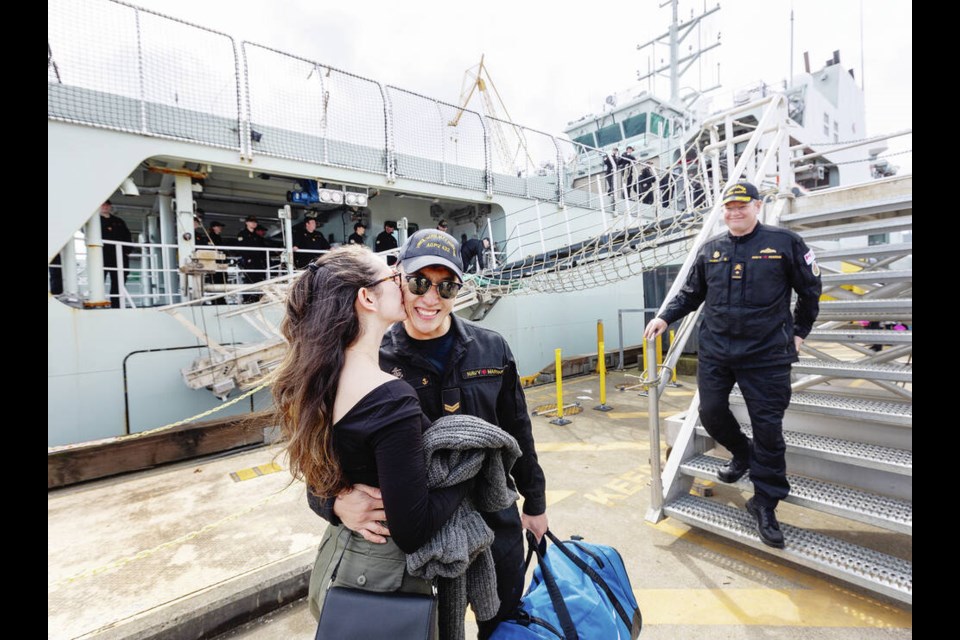Cmdr. Collin Forsberg was at the helm of HMCS Max Bernays on Monday as it arrived at CFB Esquimalt — the first time anyone has sailed a new ship into the base in 25 years.
“So it’s amazing to be the first new ship on the west coast in almost a quarter century,” he said.
He said it was a huge team effort to get the Arctic and offshore patrol vessel to its new home, one that included the blended east-west coast crew of about 70 and workers at Irving Shipyard in Halifax.
It’s due to be followed in the summer of 2026 by a second so-called Harry DeWolf-class vessel (the class is named for the first of the ships to be built) called the HMCS Robert Hampton Gray.
Four of the new Harry DeWolf-class vessels built at Irving Shipyards in Halifax are operational while another two are under construction.
CFB Halifax will eventually be home to four of the ships, while CFB Esquimalt will be home port for the other two, the Max Bernays and the Robert Hampton Gray.
Designed to assert Canadian sovereignty in the Arctic’s Northwest Passage and on the west coast, and to support international operations, HMCS Max Bernays will be officially commissioned in North Vancouver on May 3.
All in the class are being named for Canadian naval heroes.
Vancouver native Max Bernays was the coxswain on HMCS Assiniboine in the Battle of the Atlantic, and won the Conspicuous Gallantry Medal for continuing to carry out orders while surrounded by smoke and flames during a fight with a German submarine — one of just two Royal Canadian Navy members to be so honoured in the Second World War.
HMCS Max Bernays began its voyage west on March 11, followed by a fuel stop in Puerto Rico, sailing through the Panama Canal on March 24, another fuel stop and port visit in San Diego, a meeting with the U.S. Coast Guard in San Francisco and then the final leg to Esquimalt Harbour.
Commodore David Mazur, the fleet commander in the Pacific region, said a voyage through Canada’a north was considered, since HMCS Max Bernays has ice-breaking ability, but the ice conditions are currently too severe.
“They’re designed to break about one metre of ice at three knots,” he said. “We’ve seen them break almost two metres of ice on a regular occasion.”
A trip that went through the north would have had to be delayed to ensure the route was passable, but Mazur said he wanted the ship here as soon as possible.
He said Harry DeWolf-class vessels are “multi-faceted,” likening them to the navy’s “utility pickup truck.” Equipped with a 20-tonne crane, providing self-load and unload capabilities, they are designed to operate in drastically different environments — from Arctic to tropical waters — and the stern can accommodate loads such as shipping containers, underwater survey equipment or landing craft.
“They have certain inherent capability, but the real capability is that you can put almost anything you want on the vessels and modify for what you need, Mazur said.
The Pacific fleet already has five frigates that can take on a combat role, Mazur said, while the HMCS Max Bernays is designed as a patrol vessel but is also armed so it is valuable for a range of uses.
Those can include maintaining nations’ sovereignty or policing in key areas that require an armed presence, he said.
He said HMCS Max Bernays brings “a significant new capacity” to cover more locations, “whether it’s in our Arctic, in the Pacific or anywhere else the government determines that Canada’s interests require that kind of presence.”
The ship will go “straight to work” as part of RIMPAC (Rim of the Pacific), a multinational naval exercise based in Hawaii in June and July, Mazur said, and there are plans for it to go the Arctic, as well, in the summer.
For RIMPAC, there will be surgical teams on board for humanitarian aid and disaster-relief activity.
In the meantime, there will be some fine tuning and time for maintenance crews to get familiar with the new arrival, Mazur said.
As for the crew, several members from the west coast flew to Halifax in January to begin work on the ship and were greeted at Monday’s homecoming by family and friends after more than three months away.
Rebecca Ashcroft, who was there with her son, Connor, waiting for her husband, Petty Officer (second class) Geoffrey Ashcroft, said he worked hard to get an engineering position on the new ship.
“He wanted this platform,” she said. “He was looking forward to it.”
Connor held up a sign letting his dad know that he was missed “every day that ended with y.”




